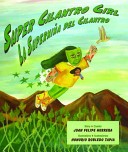
What happens when a small girl suddenly starts turning green, as green as a cilantro leaf, and grows to be fifty feet tall? She becomes Super Cilantro Girl, and can overcome all obstacles, that’s what! Esmeralda Sinfronteras is the winning super-hero in this effervescent tale about a child who flies huge distances and scales tall walls in order to rescue her mom. Award-winning writer Juan Felipe Herrera taps into the wellsprings of his imagination to address and transform the concerns many first-generation children have about national borders and immigrant status. Honorio Robledo Tapia has created brilliant images and landscapes that will delight all children.
- ISBN: 9780892391875
- Author: Herrera, Juan Felipe
- Illustrator: Robledo Tapia, Honorio
- Published: 2003 , Children's Book Press
- Themes: Emmigrants and immigrants, Heroes, immigrant, Mexican-American
- Descriptors: Fantasy, Latinx in US, Picture Book, Primary (ages 6-9), United States
- No. of pages: 32

The story addresses the theme of bringing immigrant families back together after having been separated due to deportation. Inspired by the superhero movies enjoyed during his childhood when he visited friends in Mexico and by the stories told by relatives about crossing the border, Herrera offers children a superheroine who saves her mother detained at the Mexico-US border, in Tijuana, in spite of being a citizen. Herrera’s and Robledo’s choices of words and images situate the story not only within the well-known genre of tall stories but within the culturally relevant genre of comics, so familiar to Mexican children, within a graphic novels format. In fact, the illustrator is the creator of comic strips, which have appeared in Mexican newspapers and newspapers from Los Angeles, California.
As is expected in comics and graphic novels, visual elements such as color, shading, and panel layout are as important as the author’s choice of words. The use of Spanish, English, and the art, work together to add intensity and accuracy to the drama that unfolds as the girl gets transformed into a superheroine. To illustrate this connection I want to focus on the first Spanish word that appears in the title, which is central to the whole story, the word cilantro. Cilantro is the green herb that is so salient in Mexican culinary art and in the story it seems to me works as a metaphor for Mexican culture. The cilantro is green as her “mother’s salsa verde” (green sauce), as “the earth in spring;” however, it is also green as the “Green card” visa that immigrants need to live in the US. Not surprisingly, green is the dominant color in the illustrations.
The cilantro is also shaped as “hearts with wings” communicating hope and freedom. Indeed, the protagonist’s name is “Esmeralda Sinfronteras,” an emerald without borders (sin fronteras); an identity she realizes as she flies crossing over the border with her mom. Emeralds are also green; however, the green that she loves so much gradually becomes a nightmare as her whole body changes to green, a feeling that the illustrator captures very well through some scary pictures that may make some adults to take a step back. Esmeralda cannot recognize herself anymore and falls in what could be interpreted as a crisis of identity that will get resolved when she puts over her shoulders a cape, constructs a paper mask (reminiscent of the traditional masks used by wrestlers in Mexico), and assumes her new identity as a superheroine. Indeed, the author plays with Esmeralda’s name when the nurse pronounces her name as Esmeralta, “alta means tall,” a hint of what will come next when she actually becomes Esmer-alta.” As a superheroine, she is able to save her mom and to make the cilantro grow all over the border until the border disappears (as her name indicates “sin fronteras”). The aroma or scent of the cilantro distracts the officers or border patrols who have to stop to smell it and even get inspired to speak some Spanish.
Finally, Herrera brings some humor into the quite serious theme of the story, through his choices of names that make Latino children laugh and search for potential meanings:
There we have Mr. Parches who provides a pair of gloves to the girl that she uses to cover her green hands, to fix her problem as a patch;
Mrs. Contrario (which means completely different, opposite, or contradictory), or maybe she just feels contrariada, confused by the girl’s green hair; and finally, Nurse Dedo (fingers), who with her fingers tries to give the girl an impossible haircut.
We hope you and your children enjoy this dual language text in which the author assigned equal value to both Spanish and English by using both languages on each page, using different box colors to represent the languages. Guess what is the color of the box that shows the Spanish text in the story?